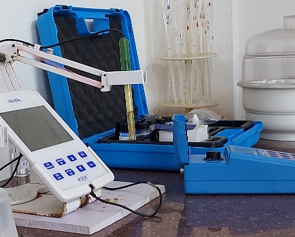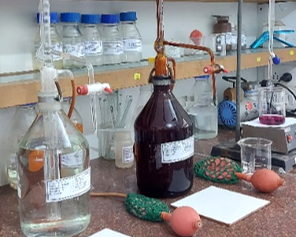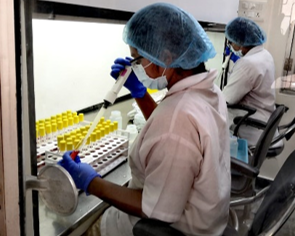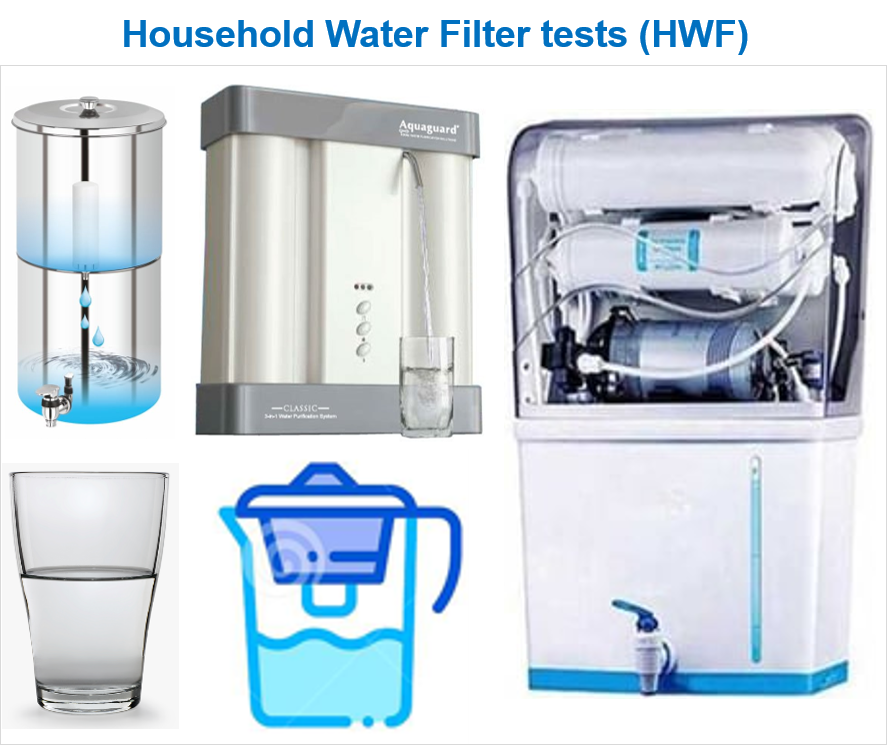Household Water Filter - tests (HWF)
Scope:

Physical & Sensory Parameters:
Colour (Appearance & True Colour Units), Odour, Turbidity, pH & Electrical Conductivity (EC); Total Dissolved Solids (TDS) estimated from EC (TDSE).

Chemical Parameters:
Hardness, Calcium (Ca), Magnesium (Mg); Nitrate (NO3), Fluoride & Boron.

Bacteriological Parameters:
Detection of Total coliforms & E. coli in 100 ml; by
Membrane Filtration & Chromogenic agar plating (MFC),
Or Enzyme Substrate Autoanalysis (ESA).
Total parameters: 5 + 6 + 2 = 13 + 1 Estimated value (TDSE)
Rationale:
Metro and municipal water supplies are prima-facie reliable sources of potable water. Raw water is mostly from surface water bodies, as is the case in Hyderabad. Total dissolved solids (TDS) of surface water sources tend to be within acceptable limits. Public water utilities monitor a wide range of quality parameters and adjust their treatment processes to deliver potable water. However, structural and operational deficiencies in transmission, storage or local distribution network may alter the quality of water dispatched by central treatment plants. Even if municipal water supply is safe to drink, deficiencies in consumer-end water storage and distribution facilities can contaminate the water consumed by people living in the respective dwellings.

For example; cracks & crevices in sump coupled with leakage nearby domestic sewage line may provide a channel for sewage contamination. Tree roots may creep and pierce through sump walls. If there is a leaky sewerage line nearby, cracks due to weathering or tree roots may open up a path for sewage contamination of stored water. The ground surrounding both the sump should be sloped down to facilitate easy drainage of rainwater away from the sump and prevent overgrowth from encroaching onto the sump. If manholes are not properly closed, bird droppings can contaminate stored water. Vulnerabilities in the overhead tank, can provide routes for contamination. If manholes are not properly closed, bird droppings can contaminate stored water. If overhead tank (OHT) manhole cover is not secured, curious and playful monkeys can displace it resulting open manholes, which would create a vulnerability for bird droppings.
The purpose of point-of-use water filters is to provide a final layer of protection to deal with occasional and inadvertent contamination events due to any vulnerability in household water storage and distribution system. Traditional household water filters based on ceramic candles, membrane filtration and ultraviolet light exposure are adequate for this purpose. Ceramic filters cost less and are most commonly used filters at the household level. Ceramic filters can have pores as small as 0.2 microns, thus removing bacteria and protozoa (but only partly removing viruses). Ceramic filters sometimes include active carbon in their core to remove taste and odour, and/or can be coated or impregnated with silver to avoid bacterial growth on the ceramic surface. The ceramic filtering element comes in a varied number of shapes: vertical/horizontal candle(s), dome-shaped, or plate. In some cases, the outlet from the ceramic candle into the lower container is equipped with a tube to increase flow, which is normally expected to be around 4 L/h. If maintained properly, ceramic candle filters can serve for up to 5 years. However, improper installation of the candle may result in leakage of untreated water from upper chamber into lower chamber holding purified water.
Membrane filtration is another most commonly used method for household filtration. The process of membrane filtration relies on pores on the membrane surface that are small enough to allow water through, while blocking pathogens that are bigger in size. Membrane filtration is split into two main categories – microfiltration and ultrafiltration – which depend on the size of particles that can be blocked. Membrane filters require regular backflushing. Microfiltration membranes with pore sizes ranging from 0.05 to 5 micron is very effective in removing protozoa, moderately effective in removing bacteria but is not effective in removing viruses. On the other hand, ultrafiltration membranes, with pore size ranging from 0.001 to 0.05 micron; has a very high effectiveness in removing protozoa, bacteria and are moderate effective in removing viruses. Nanofiltration membranes, with pore sizes ranging from 0.008 micron to 0.01 micron, are very highly effective in removing protozoa, bacteria and viruses. However, improper design giving rise to leakage, biofouling of membranes due to inadequate backflushing, and membrane tears due to excessive water pressure, may result in leakage of untreated water into the finished water path.
Many household water filters incorporate pre- and post-filtration ultraviolet (UV) light treatment to disinfect or reduce, protozoa, bacteria and viruses. UV radiation is not suitable for water with high levels of suspended solids, turbidity, color, or soluble organic matter. Many household water filters also incorporate, sediment filter and activated charcoal cartridges to remove turbidity, odour and colour. Effectiveness of UV treatment depends on characteristics of input water, effectiveness of other pre-treatment units, intensity of the UV light, exposure time etc.
Thus, several factors can affect potability of water filter output. Hence, it is desirable to periodically test household water filter output, to reassure safe operation and identify vulnerabilities, if any. In HWF we have packaged a minimal set of physical, chemical and microbial parameters, to check for wholesomeness of water delivered by household water filters. The coliform tests leading up to identification of faecal coliforms and E. coli is essential for determining whether a health risk exists. Fluoride is included as fluorosis is endemic in some areas around Hyderabad. TDS value would be a range estimated from electrical conductivity. This is a cost-effective means to reassure yourself whether the TDS range of municipal supply feeding the water filter is within acceptable limits.
Sample - Collection, Storage & Transportation:
Follow methods of sampling specified in IS 3025 part 1 : 1987 for chemical tests and in IS 1622 : 1981 for bacteriological tests. Sample should be representative of the water to be tested and should be collected with utmost care to ensure that no contamination occurs at the time of collection or prior to examination by the laboratory.
Step-1: Gather all that you need for collection of water sample:
One litre sample collected in a clean and dry clear or amber colour polypropylene bottle (CBWS/ABWS) is required for physical and chemical tests. About 250 ml of water sample collected in a sterile bottle with thiosulfate (SBT) is required for bacteriological tests. You need a pair of sample collection bottles (1xCBWS + 1xSBT), two black or dark colour polythene bags (small garbage bag will do) to minimise exposure of samples to sunlight, ice packs to keep the sample bottles cool during transport and a carry bag for convenient transport.
Both CBWS and SBT are available from the IHS Laboratory. If it is not feasible for you to collect the specified sample collection bottles from the laboratory and you must collect samples, freshly emptied packaged drinking water bottles or new PET bottles may be used, in that order. If only one freshly emptied packaged water bottle is available, then use the same to collect bacteriological sample. Do not use empty beverage bottles such as ThumsUp, Maaza, Sprite, Coca Cola for bacteriological sample. Nutrients and other residues in such bottles may promote growth of bacteria and bias test results.
Step-2: Collect sample directly from water filter outlet/faucet:
- Wash both your hands with soap and water, wipe with a clean towel and let it dry.
- Label the sample collection bottles and place it within easy reach, but do not open at this stage. Have ice packs ready.
- Then flush the water filter faucet by letting water out for 10 seconds.
- Collect the sample for physical and chemical analysis first; followed by collection of bacteriological-sample.
- Collect sample from the water filter faucet until the bottle is about to be full. Quickly cap sample bottle tightly. Wipe outside of bottle dry with a clean and dry tissue or cloth.
- Place the bottle(s) inside separate dark colour bags, tie ice packs around each of them and place it in a carry bag for transport to laboratory.
Step-3: Transport to laboratory:
Transport the samples to laboratory as soon as possible, preferably within six hours. If you have multiple errands in the same trip, plan to first deposit sample the laboratory and then continue with other activities.
Step-4 Store sample, if required:
If immediate transport is not feasible, store the sample inside the regular chamber (not the freezer compartment) of a refrigerator until you are ready to transport it to the Laboratory, and definitely within 24 hours from the time of collection.
Information About Source, Context, Intended Use & Concerns:
Provide as much detail as you can about the make & model of the water filter, date of its last servicing, whether any parts (candle, cartridge, membrane) were replaced. Mention about the reason why you are ordering the test, as well as doubts and concerns, if any. These information help in interpretation of test results. Occasionally, the IHS Laboratory may contact you for clarifications and additional information about the source and its environment, to help interpretation of test results.
Test Method & Duration:
Organoleptic, physical and chemical characteristics of water sample are tested according appropriate parts of the IS3025 and/or American Public Health Association (APHA). For bacteriological analysis methods specified in IS1622 of 1981 are used. Depending on time taken for bacteriological analysis, and gathering of additional information/clarifications, if any is required for interpretation of results; report will be available in 3 to 5 days.



To pick up sample collection bottle and/or schedule collection of samples: Email: ihslab@ihs.org.in with your address and contact telephone; OR WhatsApp: +919848011251; Or Call: 23211013/4.
References:
- APHA. 2017. Standard Methods for the Examination of Water and Wastewater, 23rd Edition. Washington, DC: American Public Health Association (APHA), American Water Works Association (AWWA), and Water Environment Federation. https://www.standardmethods.org/
- IS 1622: 1981. Indian Standard Methods of Sampling and Microbiological Examination of Water. New Delhi: Bureau of Indian Standard (BIS); Indian Standard, IS1622 - 1981, Reaffirmed 1996, Amended 2003. https://law.resource.org/pub/in/bis/S02/is.1622.1981.pdf
- IS 3025 Part 1: 1987. Methods of Sampling and Test (Physical and Chemical) for Water and Wastewater. Part 1 Sampling. New Delhi: Bureau of Indian Standard (BIS); Indian Standard. Reaffirmed 2003. https://law.resource.org/pub/in/bis/S02/is.3025.01.1987.pdf
- IS 3025 Relevant Parts: 1983. Methods of Sampling and Test (Physical and Chemical) for Water and Wastewater. Parts, 4, 10, 21,46 etc. New Delhi: Bureau of Indian Standard (BIS); Indian Standard. https://www.services.bis.gov.in/php/BIS_2.0/bisconnect/knowyourstandards/indian_standards/isdetails
- IS 10500. Indian Standard Drinking Water Specification. Second Revision. New Delhi: Bureau of Indian Standard (BIS); 2012 May. https://law.resource.org/pub/in/bis/S06/is.10500.2012.pdf
- Kozisek Frantisek. 2005. Health Risks from Drinking Demineralised Water. Ch-12 in: WHO. Nutrients in Drinking Water. Geneva: World Health Organization (WHO), 2005: 148-63. https://apps.who.int/iris/handle/10665/43403
- WHO. 2003. Total dissolved solids in Drinking-water. Background document for development of WHO Guidelines for Drinking-water Quality. Geneva: World Health Organization (WHO); 2003. https://www.who.int/teams/environment-climate-change-and-health/water-sanitation-and-health/chemical-hazards-in-drinking-water/total-dissolved-solids
- WHO. 2011. Guidelines for drinking-water quality. Fourth Edition. Geneva: 2011. https://www.who.int/publications/i/item/9789241549950
